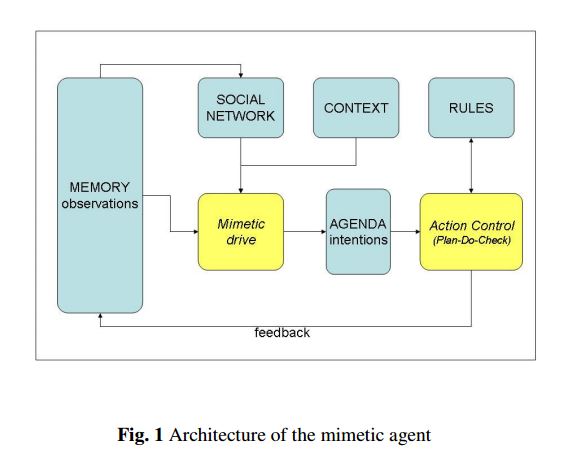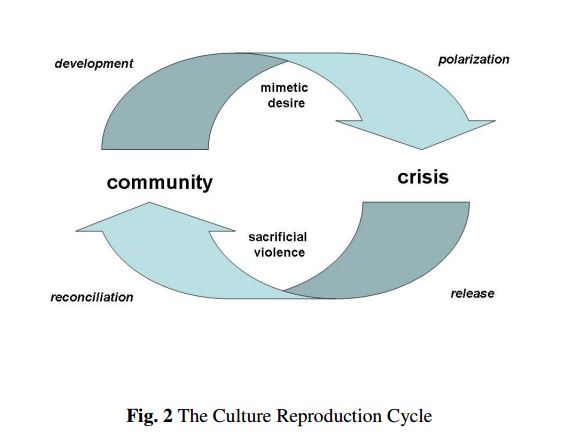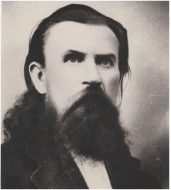|
This post assumes a familiarity with the Mimetic Lens and the Fractal Lens. See the Lenses page for more details on those. Of the three lens combinations, the intersections between the Mimetic Lens and the Fractal Lens are the most obscure, but in many ways the most intriguing. This is a frontier of understanding to be explored. The most striking similarity of these two lenses is how each starts with a simple recursive algorithm that, when repeated, develops into something of infinite complexity. In the case of the Fractal Lens, Mandelbrot showed that by repeating a simple formula and plotting the result, one could create a geometric forms that had both and infinite boundary and were infinitely complex. If you have never explored these figures, it is worth taking a digression to appreciate them with a video like this one: You'll see a lot of familiar shapes in that rendering, including those commonly used by many religions -- Buddhas, Crosses, Stars of David and Crescents are just a few. What does that mean? Honestly, I have no idea, but maybe its something to be explored later as to which recursive formula creates which symbol. On the other hand, as Sigmund Freud is reputed to have said "sometimes a cigar is just a cigar." The basic mimetic structure is also a recursive function. A mimetic rivalry is created whenever one person adopts the desires of another so that they begin competing for the same thing. Mimetic desires can spread almost like viruses to groups of people, leading to group conflicts within a community. In the same manner of fractals, complex societies can arise. Moreover, the objects of desire are virtually unlimited. At a primitive level, they can involve basic resources such as food. At a interpersonal level, they can involve competing desires for potential mates or relationship partners. At higher levels of abstraction, they can involve desires for fame, power or wealth. In addition, as as societies grow more complex, they can create new objects of desire, such as money, iphones, professional prizes, or positions to which one might be appointed or elected. Out of this one can see that virtually any human society of any level of complexity can be created out of this one recursive mimetic function, just like the infinitely complex geometric fractals. Very little has been written or explored on this interface. One interesting work is a paper entitled Complex Mimetic Systems by Hans Weigand. In this article, Weigand applies basic complexity modelling to mimetic theory in a descriptive manner. For the uninitiated, complexity modelling involves creating computer models where simulated actors, known as "agents" are put through simulations in groups to see how "societies" of such actors develop and change. Much of the most advanced work in complexity theory occurs at the Santa Fe Institute, where researchers have modeled all kinds of "societies", from financial markets to cities to biological and social systems. This work is well-described in this short video presentation: In his paper, Weigand provides a good description of the history of this kind of modelling and how simple observed human behaviors can be turned into mathematical formulas to model crowd behaviors among multiple agents who may be programmed with similar or different behaviors. For more details on complexity modelling, I would suggest The Origin of Wealth by Eric Beinhocker. He also provides some interesting diagrams. This one shows a basic structure of a mimetic agent. The agent is driven by her mimetic drive, which create a series of actions and feedback loops that affect both the agent and the society of other agents that she inhabits. This diagram depicts the society itself and the archaic pattern that Girard describes of the build-up of mimetic conflict that is resolved through sacrificial violence that is then enshrined in rules and/or rituals that maintain order in the society, generally through periodic sacrificial violence. What is missing is the connection between the two diagrams, which is easy to visualize conceptually, but thus far has not been modeled mathematically in the same manner as the Santa Fe Institute has modeled many other systems. Weigand does not attempt this feat, but notes that the field is pregnant with possibility: "In this paper, we have introduced the notion of Complex Mimetic Systems. . . .The embedding of CMS in the field of Complex Adaptive Systems and network theory [] raises interesting questions to mimetic theory. Not much attention has been given yet to the context in which mimetic forces operate, and the influence of the structure of this context on the outcome. Revealing the mimetic forces in social systems is useful as these are often left implicit both by the social agents themselves and by the social scientists. However, it is also an important scientific question how these forces work. To address this question, there is a plethora of social science literature to draw upon, as well as many research questions still to be explored. Simulation by means of computational agents is a useful instrument, if properly used in interaction with empirical studies. In most of the current research projects, the agents are not intrinsically mimetic. In this paper, we have aimed to make a next step by adopting mimetic agents right from the start. An important topic for future research is the validation of this approach by means of actual simulation experiments." Nonetheless, the parallels between these two lenses are undeniable.
1 Comment
|
I have always been curious about the way the world works and the most elegant ideas for describing and explaining it. I think I have found three of them. I was very fond of James Burke's Connections series that explored interesting intersections between ideas, and hope to create some of that magic here. Archives
February 2019
Categories
All
|



 RSS Feed
RSS Feed